The global molybdenum disulfide dry film lubricant market is valued at USD 482.7 million in 2025 and is set to reach USD 958.5 million by 2035, recording an absolute increase of USD 475.8 million over the forecast period. This translates into a total growth of 98.6%, with the market forecast to expand at a compound annual growth rate (CAGR) of 7.10% between 2025 and 2035.
The overall market size is expected to grow by approximately 2.0X during the same period, supported by increasing demand for high-performance lubrication solutions, growing adoption of dry film technologies in extreme temperature environments, and rising requirements for friction reduction systems across aerospace, automotive, electrical, and industrial machinery sectors.
Between 2025 and 2030, the molybdenum disulfide dry film lubricant market is projected to expand from USD 482.7 million to USD 690.2 million, resulting in a value increase of USD 207.5 million, which represents 43.6% of the total forecast growth for the decade.
This phase of development will be shaped by increasing demand for extreme temperature lubrication solutions, rising aerospace manufacturing activity enabling advanced friction reduction techniques, and growing availability of precision coating technologies across industrial equipment operations and automotive component manufacturing facilities.
Between 2030 and 2035, the market is forecast to grow from USD 690.2 million to USD 958.5 million, adding another USD 268.3 million, which constitutes 56.4% of the overall ten-year expansion. This period is expected to be characterized by the advancement of nanotechnology integration, the development of enhanced adhesion properties for extreme operating conditions, and the evolution of specialized formulations across diverse industrial applications.
The growing emphasis on equipment longevity and maintenance cost reduction will drive demand for advanced lubricant varieties with enhanced load-bearing capabilities, improved thermal stability characteristics, and superior anti-friction performance profiles.
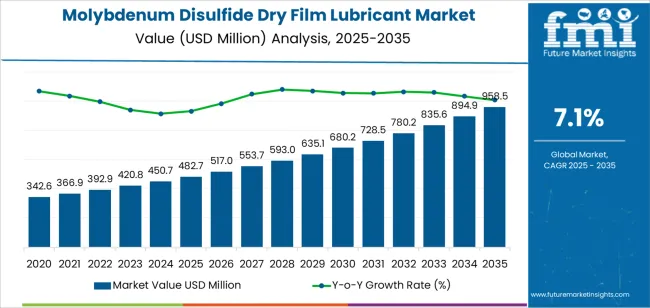
Between 2020 and 2024, the molybdenum disulfide dry film lubricant market experienced steady growth, driven by increasing aerospace component manufacturing and growing recognition of dry film technology's effectiveness in delivering consistent lubrication performance across high-temperature and vacuum environments. The market developed as manufacturers recognized the potential for molybdenum disulfide formulations to deliver operational efficiency while meeting modern requirements for equipment protection and long-term maintenance cost optimization.
Technological advancement in particle size engineering and coating application methods began emphasizing the critical importance of maintaining lubrication consistency while enhancing equipment reliability and improving operational performance across demanding industrial conditions.
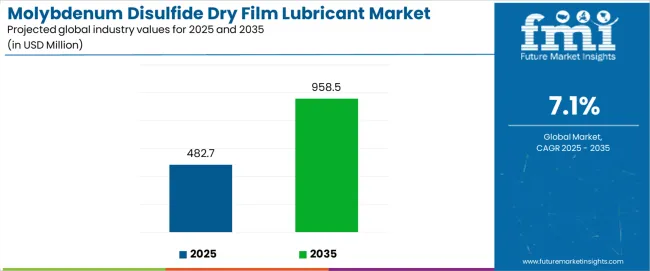
| Metric | Value |
|---|---|
| Estimated Value in (2025E) | USD 482.7 million |
| Forecast Value in (2035F) | USD 958.5 million |
| Forecast CAGR (2025 to 2035) | 7.10% |
From 2030 to 2035, the market is forecast to grow from USD 690.2 million to USD 958.5 million, adding another USD 268.3 million, which constitutes 56.4% of the overall ten-year expansion. This period is expected to be characterized by the advancement of precision particle engineering systems, the integration of enhanced bonding agents for improved surface adhesion, and the development of specialized temperature-resistant formulations for extreme operating environments. The growing emphasis on maintenance interval extension and operational cost reduction will drive demand for premium varieties with enhanced wear protection credentials, improved chemical resistance options, and superior durability characteristics.
Between 2020 and 2024, the molybdenum disulfide dry film lubricant market experienced robust growth, driven by increasing awareness of friction reduction benefits and growing recognition of dry film systems' effectiveness in supporting efficient maintenance operations across aerospace facilities and precision manufacturing services.
The market developed as users recognized the potential for specialized lubricant formulations to deliver productivity advantages while meeting modern requirements for consistent performance quality and reliable equipment protection. Technological advancement in coating application processes and quality control systems began emphasizing the critical importance of maintaining film thickness standards while extending service intervals and improving customer satisfaction across diverse industrial applications.
Market expansion is being supported by the increasing global demand for high-performance lubrication solutions and the corresponding shift toward advanced dry film technologies that can provide superior operational characteristics while meeting user requirements for extreme temperature resistance and cost-effective maintenance processes.
Modern manufacturers are increasingly focused on incorporating lubrication systems that can enhance equipment longevity while satisfying demands for consistent, precisely controlled friction reduction and optimized maintenance scheduling practices. Molybdenum disulfide dry film lubricants' proven ability to deliver operational efficiency, equipment protection, and diverse application possibilities makes them essential components for aerospace manufacturers and quality-conscious industrial professionals.
The growing emphasis on extreme environment applications and equipment optimization is driving demand for high-performance lubrication systems that can support distinctive operating outcomes and comprehensive equipment protection across aerospace components, precision machinery, and specialty manufacturing applications. User preference for lubricants that combine functional excellence with operational flexibility is creating opportunities for innovative implementations in both traditional and emerging industrial applications.
The rising influence of automated manufacturing processes and advanced equipment technologies is also contributing to increased adoption of specialized dry film lubricants that can provide authentic performance benefits and reliable operational characteristics.
The market is segmented by type, application, particle size, coating method, and region. By type, the market is divided into conventional type, fast-drying type, temperature-resistant type, electrically conductive type, and others. Based on application, the market is categorized into aerospace industry, automotive industry, electrical industry, textile industry, oil and gas industry, marine and steel industry, and others.
By particle size, the market includes nano-scale particles, micro-scale particles, and standard particles. By coating method, the market encompasses spray application, brush application, dip coating, and electrostatic application. Regionally, the market is divided into North America, Europe, Asia Pacific, Latin America, Middle East & Africa, and other regions.
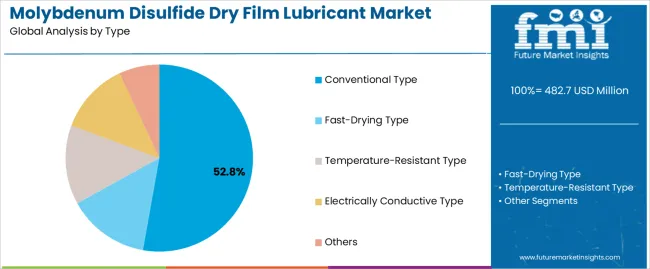
The conventional type segment is projected to account for 52.8% of the molybdenum disulfide dry film lubricant market in 2025, reaffirming its position as the leading product category. Manufacturers and industrial professionals increasingly utilize conventional type formulations for their superior cost-effectiveness, established performance standards, and essential functionality in diverse lubrication applications across multiple industry types. Conventional type lubricants' proven performance characteristics and established reliability directly address user requirements for dependable equipment protection and optimal friction reduction in standard operating conditions.
This product segment forms the foundation of modern industrial lubrication patterns, as it represents the formulation category with the greatest operational versatility potential and established compatibility across multiple equipment systems. Business investments in proven technology and performance optimization continue to strengthen adoption among cost-conscious manufacturers. With users prioritizing lubrication consistency and equipment reliability, conventional type formulations align with both productivity objectives and budget requirements, making them the central component of comprehensive maintenance strategies.
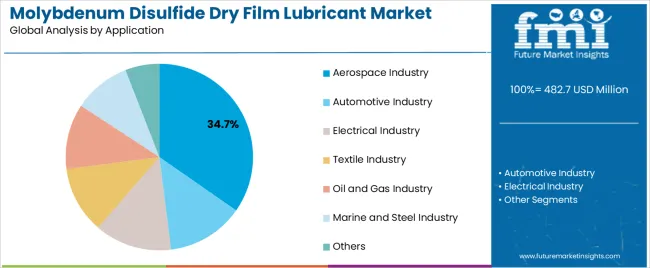
Aerospace industry is projected to represent 34.7% of the molybdenum disulfide dry film lubricant market in 2025, underscoring its critical role as the primary application for quality-focused manufacturers seeking superior lubrication efficiency benefits and enhanced component performance credentials.
Aerospace engineers and manufacturing professionals prefer aerospace applications for their established performance requirements, proven reliability standards, and ability to maintain exceptional operational quality while supporting demanding environmental conditions during diverse aerospace projects. Positioned as essential applications for performance-conscious manufacturers, aerospace offerings provide both operational excellence and competitive positioning advantages.
The segment is supported by continuous improvement in lubrication technology and the widespread availability of established performance standards that enable quality assurance and premium positioning at the manufacturer level. Aerospace companies are optimizing lubricant selections to support component differentiation and performance enhancement strategies. As lubrication technology continues to advance and manufacturers seek reliable protection methods, aerospace applications will continue to drive market growth while supporting business development and quality assurance strategies.
The molybdenum disulfide dry film lubricant market is advancing rapidly due to increasing performance consciousness and growing need for extreme environment lubrication solutions that emphasize superior friction reduction outcomes across aerospace segments and industrial applications. The market faces challenges, including competition from alternative lubrication technologies, application complexity requirements, and formulation cost pressures affecting operational economics. Innovation in nanotechnology integration and advanced coating methods continues to influence market development and expansion patterns.
Expansion of Aerospace and High-Temperature Applications
The growing adoption of molybdenum disulfide dry film lubricants in aerospace components and high-temperature industrial equipment is enabling manufacturers to develop lubrication strategies that provide distinctive performance benefits while commanding competitive positioning and enhanced operational characteristics. Aerospace applications provide superior temperature resistance while allowing more sophisticated friction control features across various component categories. Users are increasingly recognizing the operational advantages of dry film positioning for premium performance outcomes and efficiency-conscious equipment integration.
Integration of Nanotechnology and Advanced Particle Engineering
Modern molybdenum disulfide dry film lubricant manufacturers are incorporating advanced particle engineering technologies, nanotechnology integration systems, and precision coating methods to enhance operational performance, improve adhesion characteristics, and meet industrial demands for intelligent lubrication solutions. These systems improve operational effectiveness while enabling new applications, including ultra-thin film coatings and precision equipment protection protocols. Advanced nanotechnology integration also allows manufacturers to support performance leadership positioning and quality assurance beyond traditional lubrication operations.
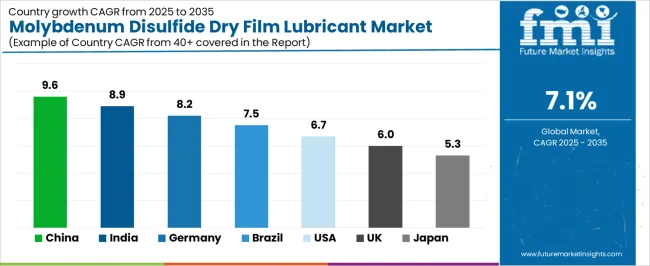
| Country | CAGR (2025 to 2035) |
|---|---|
| China | 9.6% |
| India | 8.9% |
| Germany | 8.2% |
| Brazil | 7.5% |
| USA | 6.7% |
| UK | 6.0% |
| Japan | 5.3% |
The molybdenum disulfide dry film lubricant market is experiencing robust growth globally, with China leading at a 9.6% CAGR through 2035, driven by the expanding aerospace manufacturing industry, growing precision equipment requirements, and increasing adoption of advanced lubrication systems. India follows at 8.9%, supported by rising industrial development, expanding manufacturing sector, and growing acceptance of high-performance lubrication solutions.
Germany shows growth at 8.2%, emphasizing established manufacturing capabilities and comprehensive lubrication technology development. Brazil records 7.5%, focusing on industrial expansion and equipment maintenance growth. The USA demonstrates 6.7% growth, prioritizing advanced lubrication technologies and equipment optimization.
The report covers an in-depth analysis of 40+ countries, Top-performing countries are highlighted below.
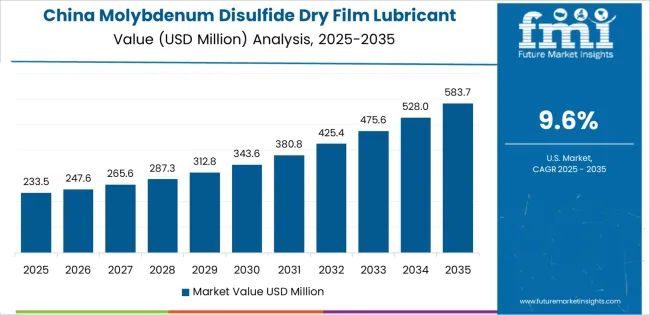
Revenue from molybdenum disulfide dry film lubricant consumption and sales in China is projected to exhibit exceptional growth with a CAGR of 9.6% through 2035, driven by the country's rapidly expanding aerospace sector, favorable government policies toward advanced manufacturing development, and initiatives promoting high-performance lubrication technologies across major industrial regions.
China's position as a leading manufacturing hub and increasing focus on precision equipment systems are creating substantial demand for high-quality molybdenum disulfide dry film lubricants in both domestic and export markets. Major aerospace companies and manufacturing contractors are establishing comprehensive lubrication capabilities to serve growing demand and emerging market opportunities.
Revenue from molybdenum disulfide dry film lubricant products in India is expanding at a CAGR of 8.9%, supported by rising manufacturing investment, growing industrial development, and expanding precision equipment capabilities.
The country's developing aerospace sector and increasing commercial investment in advanced lubrication technologies are driving demand for molybdenum disulfide dry film lubricants across both traditional and modern industrial applications. International chemical companies and domestic distributors are establishing comprehensive operational networks to address growing market demand for quality lubricants and efficient maintenance solutions.
Revenue from molybdenum disulfide dry film lubricant products in Germany is projected to grow at a CAGR of 8.2% through 2035, supported by the country's mature aerospace sector, established lubrication standards, and leadership in precision manufacturing technology.
Germany's sophisticated industrial infrastructure and strong support for advanced lubrication systems are creating steady demand for both traditional and innovative lubricant varieties. Leading chemical manufacturers and specialty distributors are establishing comprehensive operational strategies to serve both domestic markets and growing export opportunities.
Revenue from molybdenum disulfide dry film lubricant products in Brazil is projected to grow at a CAGR of 7.5% through 2035, driven by the country's emphasis on industrial expansion, manufacturing development, and growing precision equipment capabilities.
Brazilian manufacturers and industrial companies consistently seek commercial-grade lubricants that enhance equipment performance and support operational excellence for both traditional and modern industrial applications. The country's position as a Latin American manufacturing leader continues to drive innovation in specialized lubrication applications and commercial equipment standards.
Revenue from molybdenum disulfide dry film lubricant products in the USA is projected to grow at a CAGR of 6.7% through 2035, supported by the country's emphasis on aerospace technology advancement, equipment optimization, and advanced manufacturing integration requiring efficient lubrication solutions.
American manufacturers and industrial users prioritize performance reliability and operational precision, making specialized lubricants essential components for both traditional and modern industrial applications. The country's comprehensive technology leadership and advancing manufacturing patterns support continued market expansion.
Revenue from molybdenum disulfide dry film lubricant products in the UK is projected to grow at a CAGR of 6.0% through 2035, supported by established lubrication standards, mature manufacturing markets, and emphasis on equipment reliability across aerospace and industrial sectors.
British manufacturers and industrial professionals prioritize quality performance and operational consistency, creating steady demand for premium lubrication solutions. The country's comprehensive market maturity and established manufacturing practices support continued development in specialized applications.
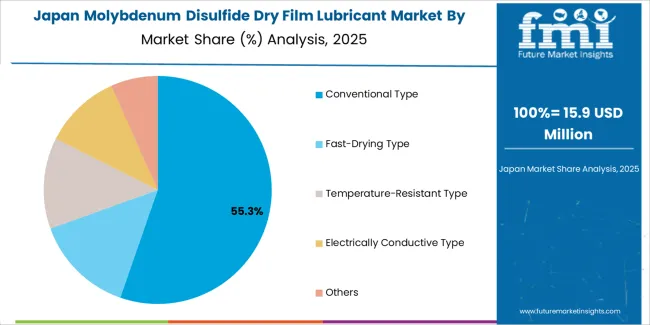
Revenue from molybdenum disulfide dry film lubricant products in Japan is projected to grow at a CAGR of 5.3% through 2035, supported by the country's emphasis on precision manufacturing, quality excellence, and advanced technology integration requiring efficient lubrication solutions. Japanese businesses and industrial users prioritize technical performance and manufacturing precision, making specialized lubricants essential components for both traditional and modern industrial applications. The country's comprehensive quality leadership and advancing manufacturing patterns support continued market expansion.
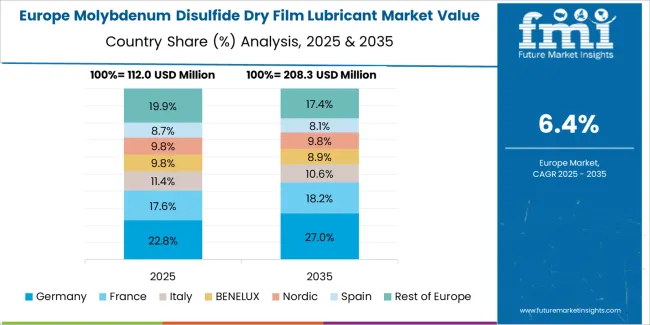
The Europe molybdenum disulfide dry film lubricant market is projected to grow from USD 158.9 million in 2025 to USD 315.4 million by 2035, recording a CAGR of 7.4% over the forecast period. Germany leads the region with a 38.2% share in 2025, moderating slightly to 37.8% by 2035, supported by its strong aerospace base and demand for premium, technically advanced lubrication solutions. The United Kingdom follows with 26.4% in 2025, easing to 26.0% by 2035, driven by a mature aerospace market and emphasis on equipment reliability and performance optimization.
France accounts for 15.8% in 2025, rising to 16.3% by 2035, reflecting steady adoption of advanced lubrication solutions and operational efficiency enhancement. Italy holds 10.2% in 2025, expanding to 10.8% by 2035 as precision manufacturing and specialty industrial applications grow.
Spain contributes 5.4% in 2025, growing to 5.7% by 2035, supported by expanding industrial sector and equipment modernization. The Nordic countries rise from 2.8% in 2025 to 3.0% by 2035 on the back of strong technology adoption and advanced manufacturing methodologies. BENELUX remains at 1.2% share across both 2025 and 2035, reflecting mature, precision-focused industrial markets.
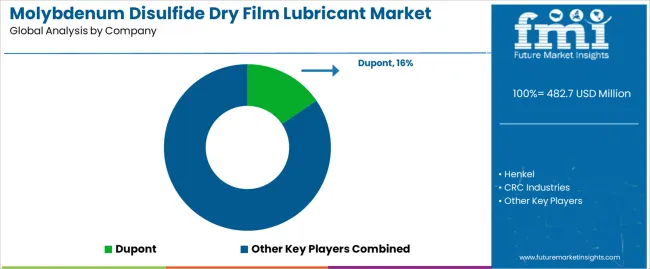
The molybdenum disulfide dry film lubricant market is characterized by competition among established chemical manufacturers, specialized lubricant producers, and integrated industrial solution companies. Companies are investing in advanced formulation technologies, particle engineering development systems, product innovation capabilities, and comprehensive distribution networks to deliver consistent, high-quality, and reliable molybdenum disulfide dry film lubricant systems. Innovation in performance enhancement, temperature resistance optimization, and application-specific product development is central to strengthening market position and customer satisfaction.
Dupont leads the market with a strong focus on chemical innovation and comprehensive molybdenum disulfide dry film lubricant solutions, offering commercial formulation systems with emphasis on manufacturing excellence and technological heritage. Henkel provides specialized industrial lubricants with a focus on precision market applications and performance engineering networks. CRC Industries delivers integrated lubrication solutions with a focus on contractor positioning and operational efficiency. Fuchs specializes in comprehensive industrial lubricants with an emphasis on high-performance applications. DMR Group focuses on comprehensive specialty lubricants with advanced formulation and premium positioning capabilities.
The success of molybdenum disulfide dry film lubricants in meeting commercial lubrication demands, manufacturer-driven efficiency requirements, and performance integration will not only enhance industrial operational outcomes but also strengthen global specialty chemical manufacturing capabilities. It will consolidate emerging regions' positions as hubs for efficient lubricant production and align advanced economies with commercial lubrication systems.
This calls for a concerted effort by all stakeholders -- governments, industry bodies, manufacturers, distributors, and investors. Each can be a crucial enabler in preparing the market for its next phase of growth.
| Items | Values |
|---|---|
| Quantitative Units (2025) | USD 482.7 million |
| Type | Conventional Type, Fast-Drying Type, Temperature-Resistant Type, Electrically Conductive Type, Others |
| Application | Aerospace Industry, Automotive Industry, Electrical Industry, Textile Industry, Oil and Gas Industry, Marine and Steel Industry, Others |
| Particle Size | Nano-Scale Particles, Micro-Scale Particles, Standard Particles |
| Coating Method | Spray Application, Brush Application, Dip Coating, Electrostatic Application |
| Regions Covered | North America, Europe, Asia Pacific, Latin America, Middle East & Africa, Other Regions |
| Countries Covered | China, India, Germany, Brazil, United States, United Kingdom, Japan, and 40+ countries |
| Key Companies Profiled | Dupont , Henkel, CRC Industries, Fuchs, DMR Group, and other leading molybdenum disulfide dry film lubricant companies |
| Additional Attributes | Dollar sales by type, application, particle size, coating method, and region; regional demand trends, competitive landscape, technological advancements in formulation engineering, precision manufacturing initiatives, performance enhancement programs, and premium product development strategies |
The global molybdenum disulfide dry film lubricant market is estimated to be valued at USD 482.7 million in 2025.
The market size for the molybdenum disulfide dry film lubricant market is projected to reach USD 958.5 million by 2035.
The molybdenum disulfide dry film lubricant market is expected to grow at a 7.1% CAGR between 2025 and 2035.
The key product types in molybdenum disulfide dry film lubricant market are conventional type, fast-drying type, temperature-resistant type, electrically conductive type and others.
In terms of application, aerospace industry segment to command 34.7% share in the molybdenum disulfide dry film lubricant market in 2025.






Full Research Suite comprises of:
Market outlook & trends analysis
Interviews & case studies
Strategic recommendations
Vendor profiles & capabilities analysis
5-year forecasts
8 regions and 60+ country-level data splits
Market segment data splits
12 months of continuous data updates
DELIVERED AS:
PDF EXCEL ONLINE
Molybdenum Disilicide Market Size and Share Forecast Outlook 2025 to 2035
Molybdenum-99 Market Size, Share, and Forecast 2025 to 2035
Molybdenum Market Insights – Size, Share & Industry Growth 2025 to 2035
Molybdenum Cofactor Deficiency Type-A (MoCoD-A) Treatment Market Analysis by Drug Class, Route of Administration, Distribution Channel, and Region through 2025 to 2035
Molybdenum Disulfide (MoS2) Crystal Market Size and Share Forecast Outlook 2025 to 2035
Molybdenum Disulfide Market
Carbon Disulfide Market - Trends & Analysis 2025 to 2035
Lubricant Market Size and Share Forecast Outlook 2025 to 2035
Lubricants / Slip Agents Market Size and Share Forecast Outlook 2025 to 2035
Lubricant Packaging Market Analysis - Size, Share, and Forecast Outlook 2025 to 2035
Lubricant Testing Machine Market Size and Share Forecast Outlook 2025 to 2035
Lubricant Additives Market Growth - Trends & Forecast 2025 to 2035
Examining Market Share Trends in the Lubricant Packaging Industry
Lubricants for Cement Industry Market
USA Lubricant Contaminated HDPE Container Waste Market Size and Share Forecast Outlook 2025 to 2035
Mining Lubricant Market Size and Share Forecast Outlook 2025 to 2035
Firearm Lubricants Market Demand & Growth 2025 to 2035
Plastic Lubricants Market
Aircraft Lubricant Market Size and Share Forecast Outlook 2025 to 2035
Market Share Distribution Among Forestry Lubricants Manufacturers

Thank you!
You will receive an email from our Business Development Manager. Please be sure to check your SPAM/JUNK folder too.
Chat With
MaRIA